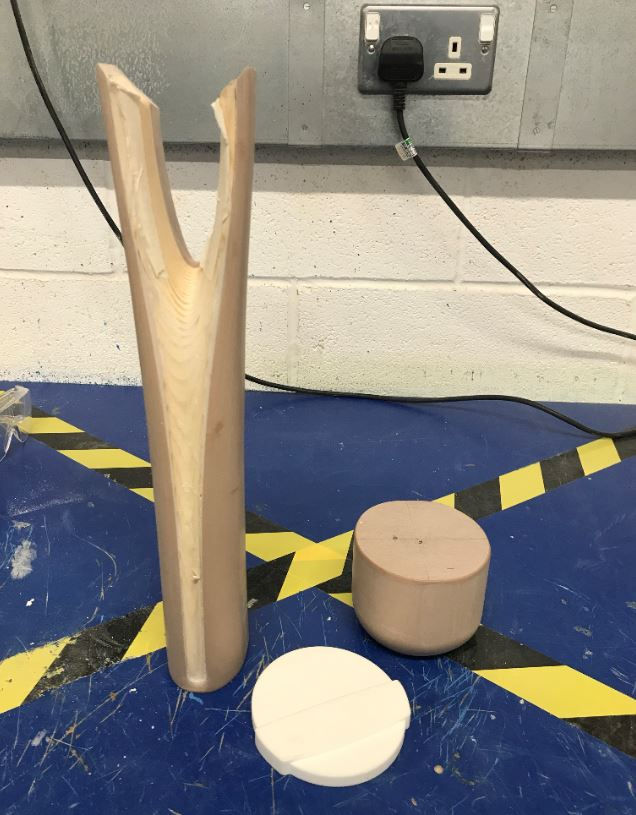Materials and tools, Orthographic drawing and Project plan
- remicatchpole
- Feb 16, 2021
- 4 min read
There are a range of making methods and processes for my model, what materials, tools, and techniques I can use. There are lots of different ways to make miniatures, such as modelling or shaping. David Neat mentions in his blog that “the main thing is ... ‘organic’ shapes with little geometric regularity such as human figures or trees are more easily modelled, whereas more streamlined forms such as domes or niches are more easily achieved by controlled shaping.” The difference between the two is that modelling is an additive process generally using soft material, whereas shaping is subtractive. One advantage of modelling over shaping is that you can back-track if you have made a mistake. This makes modelling more of a free-flowing process which allows for improvisation, chance, and taking more risks. Shaping requires more anticipation and planning.
Out of all the materials for modelling natural clay remains the most reliable and versatile, but due to the fact it dries, shrinks, and cracks over time it is not suitable for modelmaking. However, there are many alternatives such as plasticine clays that remain soft and workable almost indefinitely. Some examples of these are modelling wax, plasticine, chavant, and plastilene. Most of these cannot be made hard and durable. Though, polymer clays such as Super Sculpey can be hardened, oven baked, and painted to finish. The main advantage of using Super Sculpey is that “It is an ideal modelling material for those who are looking for something similar to plasticine but which can be made permanent if needed.” “Super Sculpey is popular in both film and toy-making industries as a material for character maquettes.” An alternative to this could be to use the method of moulding and casting with polyurethane resin, “Because of its ease of use polyurethane resin is the most common choice for small-scale casting and home craft-work. It is commonly opaque and fast setting.” The main disadvantage of this method is that its more expensive. It also requires specialist tools and equipment which are currently unavailable to us as we are working from home. Another alternative material to use could be Milliput. An advantage Milliput has over Super Sculpey is that it's much stronger, but it gets sticky, making detailed modelling difficult.
There are lots of methods and processes involved with making miniatures. One of which is modelling a figure directly onto a drawing. Davis Neat mentions in his blog that “The idea with this is that the complete front half is modelled, the material is then hardened, after which the back half can be continued directly onto it. The big advantage here is that the drawing imposes clear limits i.e. it is almost impossible not to get the general proportions and shape of the figure right if one keeps to the drawing.”

“I’m using Super Sculpey here, a flesh-coloured polymer clay which, as I’ve said, is one of the softest and most malleable. It hardens with heat, which means that the usual way is to bake it in a normal oven (130 degrees centigrade, c.15 mins for each 6mm of thickness used), but it can also be hardened quite well using a hot-air gun, which is better for the task here.”
“The disadvantage of this method of ‘modelling flat on a template’ is that obviously it works better for forms which keep mainly to one plane, as with this figure ‘standing to attention’.” This tells me that this method of making might not be suitable for my model as the figures I am sculpting will be in dynamic poses.
Therefore, the best method of making for me would be to create body cores out of armature wire and foil to sculpt over. “Normally a sculptor builds up a modelled figure on an armature, which is a skeletal support for the figure usually out of wire, and it makes sense to do that even at this small scale. Getting the armature right is more than half of the task, at least in terms of importance. A good armature is not only there for structural support, it should also be as far as possible a guide as to where to put the clay … it should impose some control.”

When making model figures it is also very important to keep to the right scale and proportions of the human body. “We need to know what the human figure looks like and, just as importantly, what it looks like at 1:25 scale. When I’m modelling in 1:25 scale I work from visual cue sheets such as these ones. For these I’ve taking the trouble, not only to find the clearest, most authentic looking and most general models for the proportions and details of the human figure but I’ve also adjusted them all in size to fit the 1:25 scale.”

“For these I’ve looked at various sources … anatomy books for artists, figure reference websites, medical books.”
When modelling, it is also important to be using the correct tools. These are a variety of plastic and wooden sculpting tools, scalpels, an knifes. Some are finer and pointed mostly used to add detail, and some are more rounded and used as embossing tools.

Just as much can also be achieved using tools which aren't made for modelling, especially when it comes to surfacing effects. Texturing tools even be made from Super Sculpey itself, here are some examples of the types of tools that can be used.


This is the Orthographic drawing and final design of my model, with all measurements and materials annotated.

This is the list I made to plan out the measurements the scale of my model, the method and process to making my model, and the materials and tools I will use.



Comments